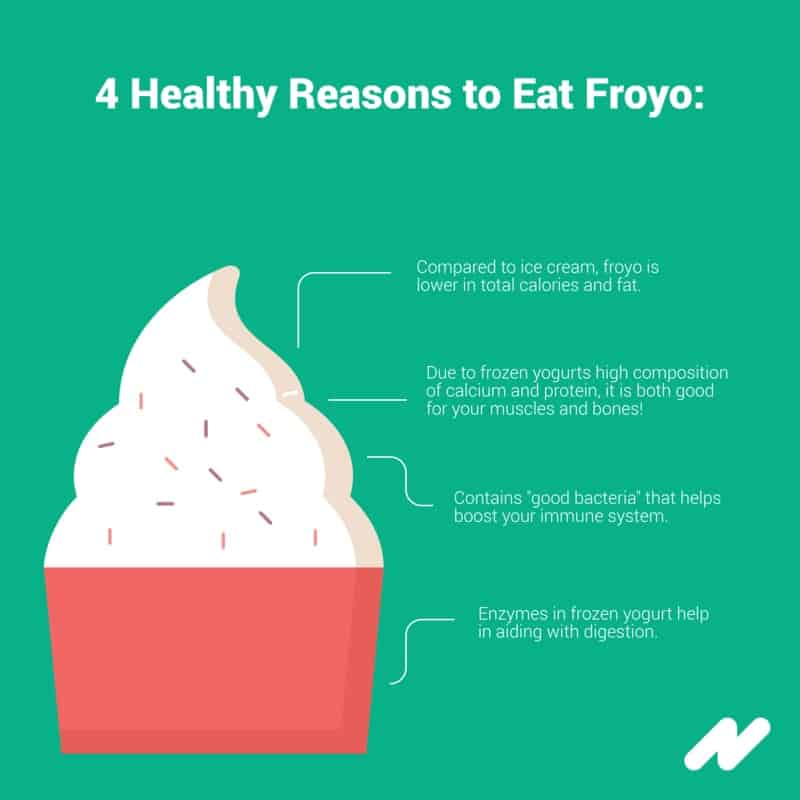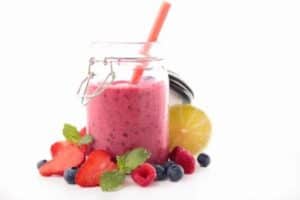Is Frozen Yogurt Healthy?
Yes! A big, happy, astounding yes. The biggest obstacle you are going to run into with the whole “is frozen yogurt healthy” question, are toppings. Frozen yogurt is famous for the toppings you put on it. The bright side is that the choice is entirely in your hands.
Some people might choose to weigh their froyo down with syrup, caramel, chocolate chips, maraschino cherries, etc. Others might prefer to use healthier options, such as sliced fruit or granola instead. One of the best things about frozen yogurt is how easily it can be customized for the individual enjoying it.
How Is Frozen Yogurt Made?
The geniuses behind the invention of frozen yogurt realized that if they use milk in their recipe instead of cream, the result is a much healthier (yet just as tasty) dessert. Other ingredients in a typical store-bought serving of frozen yogurt include some type of sweetener (usually something like corn syrup), assorted flavorings (depending on the variety being made), gelatin, yogurt cultures, and emulsifiers.
As for how it is actually made, it is quite simple. However, you will need an appliance that not everyone has– an ice cream maker. Fortunately, you can get them easily, and they relatively inexpensive these days. Besides, once you try homemade froyo, you will want more. You will get more than your money’s worth out of it in the not so distant future.
Potential Health Benefits of Frozen Yogurt
- It contains Lactobacillus bulgaricus and Streptococcus thermophilus, which are bacteria that are actually good for you.
- It is naturally low in calories.
- You can find (or make) varieties that are low in sugar, making it a good treat for people with diabetes or other health issues.
- It has probiotics, which are good live bacteria that help keep your gut healthy and are excellent for your digestive system. This means they can assist with digestive issues.
Variations of Frozen Yogurt
You could eat frozen yogurt every day of your life and always find a new variety of it to enjoy. There is nonfat, low-fat, and even greek yogurt to choose from. Just as with the old fashioned type of yogurt, the consistencies of frozen yogurt differ due to the fat content.
There are also a variety of flavors available. Some people choose a plain yogurt as their base and then dress it up with assorted toppings or their favorite fruit or granola.
Frozen Greek Yogurt
Frozen greek yogurt is an excellent option if you are looking for protein. It has nearly double the protein of its low-fat and nonfat counterparts. It also contains half the sodium and half the carbohydrates.
Another great thing about frozen greek yogurt is the texture. Many people feel like it’s creamier than other varieties. This makes it an excellent choice for a frozen treat.
Frozen Yogurt vs. Ice Cream: Which Is Better?
There has been a “frozen yogurt vs. ice cream” debate since the former was first invented over four decades ago.
The real difference between the two comes down to the fat content. Take one cup of vanilla, for example. The ice cream contains 275 calories. The frozen yogurt contains 221. This is a difference worth appreciating, but what is really noticeable is the difference in fat content.
The vanilla ice cream has 15 grams of fat and 9 grams of saturated fat. The frozen yogurt has 6 grams of fat and 4 grams of saturated fat. That’s less than half of the fat. When you are watching your waistline or just trying to maintain a general state of health, that’s nothing to sneeze at.
As for which tastes better, that depends on the person consuming it. One thing is for sure, though, it’s nice to have choices when it comes to what kind of food we put into our body.
How to Make Frozen Yogurt at Home
It is actually far easier to make frozen yogurt at home than you might realize. In fact, you can make it by using just three simple ingredients. Whichever type of yogurt you are choosing to use (low-fat, nonfat, or greek), raw honey, and vanilla extract.
The most important thing you will need to be sure you have available to you is not something you can purchase in a store: it’s your patience. After all, making any type of frozen treat takes a bit of time and experimentation. You will need to be patient with yourself as you get the consistency right. Don’t worry, though. It will be worth it when it hits your taste buds.






